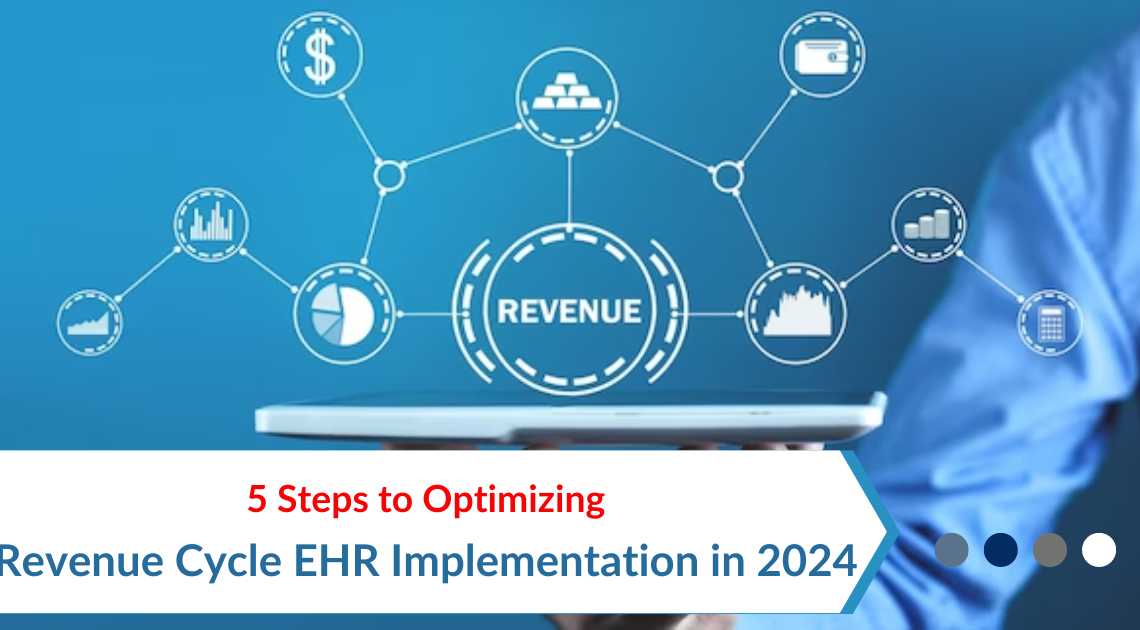In the ever-evolving landscape of healthcare, effective Revenue Cycle Management (RCM) is paramount for the financial well-being of healthcare organizations. As technology continues to advance, integrating Electronic Health Records (EHR) into your RCM strategy becomes increasingly critical. In this comprehensive guide, we’ll delve into the five essential steps to optimize Revenue Cycle Management through EHR implementation in 2024.
-
Comprehensive Analysis of RCM in Healthcare
Before embarking on any major change, it’s crucial to perform a comprehensive analysis of your current Revenue Cycle Management practices. This initial step is the bedrock of your entire EHR implementation strategy. By gaining a deep understanding of your organization’s existing workflows, pinpointing pain points, and setting clear benchmarks for improvement, you set the stage for a successful EHR integration.
Begin by conducting a thorough assessment of your current RCM processes. Identify areas that can benefit from automation, streamlined workflows, and reduced manual intervention. Gather data on key performance indicators (KPIs) such as denial rates, days in accounts receivable, and clean claim rates. This data will serve as your baseline for measuring the impact of EHR implementation on your revenue cycle.
-
Selecting the Right Revenue Cycle Management EHR
Selecting the right EHR system for your organization is a pivotal decision. A well-chosen EHR aligns with your RCM objectives, offers scalability to accommodate your growth, and provides the necessary tools to streamline processes. It must also be compliant with healthcare regulations and seamlessly integrate with your existing systems.
To make an informed decision, involve key stakeholders from various departments, including finance, IT, and clinical staff. Collaborate closely with EHR vendors and request detailed demonstrations of their systems. Evaluate how each system handles core RCM functions such as coding, billing, claims management, and patient data management.
Consider the flexibility of the EHR in adapting to your unique workflows. The system should support customization to accommodate your organization’s specific needs. Additionally, assess the vendor’s reputation, customer support, and their track record in successfully implementing EHRs in healthcare settings.
-
EHR Implementation and Training
With the right EHR system selected, it’s time to embark on the implementation process. EHR implementation is a complex undertaking that requires careful planning, project management, and collaboration across departments.
Begin by creating a detailed implementation plan that outlines the timeline, milestones, and responsibilities. Assign dedicated project managers and a cross-functional implementation team to oversee the process. Effective communication and collaboration between IT, clinical staff, and administrative teams are key to success.
A critical component of EHR implementation is staff training. Ensure that all users, from clinicians to billing specialists, receive comprehensive training on the new system. Training should cover EHR navigation, data entry, coding, billing procedures, and compliance requirements. Consider offering ongoing training and support to address any questions or challenges that arise post-implementation.
-
Streamlining Revenue Cycle Management Workflows
Once your EHR system is in place, the focus shifts to optimizing your Revenue Cycle Management workflows. The goal is to leverage the capabilities of your EHR to automate repetitive tasks, reduce manual data entry, and minimize errors. Implementing best practices for coding, billing, and claims management will accelerate revenue generation and improve cash flow.
Here are some specific areas where EHRs can enhance RCM workflows:
- Automated Coding: EHRs can assist in accurate and efficient medical coding by suggesting appropriate codes based on clinical documentation. This reduces coding errors and improves claim accuracy.
- Claims Management: EHRs can help in the timely submission of claims by automating the process and providing real-time claim status updates. This reduces the risk of claim denials and delays in reimbursement.
- Patient Data Management: EHRs centralize patient information, making it easier to verify insurance eligibility, collect patient payments, and send out patient statements. This improves the patient experience and increases revenue collection.
- Analytics and Reporting: EHRs offer robust reporting and analytics capabilities that allow you to monitor RCM performance in real-time. Use these tools to identify bottlenecks, track KPIs, and make data-driven decisions for continuous improvement.
Remember that the success of workflow optimization lies in ongoing monitoring and refinement. Regularly review your RCM processes and adjust them as needed to adapt to changes in regulations, payer requirements, and industry best practices.
-
Continuous Monitoring and Improvement
The healthcare industry is in a constant state of flux, with new regulations, evolving payer requirements, and shifting patient expectations. To maintain optimal RCM performance, it’s imperative to establish a system for continuous monitoring and improvement.
Start by defining a set of key performance indicators (KPIs) that align with your RCM goals. These KPIs should cover areas such as revenue cycle duration, denial rates, clean claim rates, and accounts receivable aging. Regularly track and analyze these metrics to gain insights into the health of your revenue cycle.
Proactively identify and address issues as they arise. For example, if you notice a sudden increase in claim denials, investigate the root causes and implement corrective measures. Stay abreast of industry trends and regulatory changes that may impact your RCM processes, and adapt your strategies accordingly.
Foster a culture of continuous improvement within your organization. Encourage feedback from staff involved in the revenue cycle and EHR implementation. Use this feedback to fine-tune workflows, optimize system configurations, and enhance training programs.
In Conclusion
As 2024 unfolds, Revenue Cycle Management in healthcare necessitates a strategic approach that incorporates Electronic Health Records. By meticulously following these five critical steps-conducting a comprehensive analysis, selecting the right EHR, effective implementation and training, streamlining workflows, and continuous improvement-your organization can significantly enhance its financial health, ensure compliance, and provide superior patient care.
The healthcare industry’s ongoing transformation demands that healthcare organizations stay ahead of the curve. Implementing these steps will not only optimize your revenue cycle but also position your organization for growth and resilience in the dynamic healthcare landscape of 2024. EHR implementation is not merely a technological upgrade; it’s a strategic move that can bolster your organization’s financial stability and capacity to deliver high-quality care to your patients.



